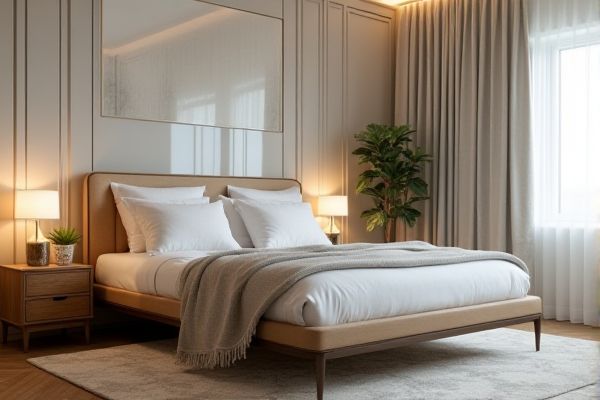
Low-profile beds offer a minimalist design and easier access for people with mobility issues, while standard height beds provide additional under-bed storage space and often align better with traditional bedroom furniture. Explore the rest of the article to discover which bed height best suits your comfort and lifestyle needs.
Table of Comparison
| Feature | Low-Profile Bed | Standard Height Bed |
|---|---|---|
| Height | 10 to 14 inches | 18 to 25 inches |
| Ease of Access | Ideal for children, elderly, or limited mobility | Requires more effort to get in and out |
| Aesthetic | Modern, minimalist look | Traditional, versatile styles |
| Under-bed Storage | Limited to none | Usually ample storage space |
| Comfort | Closer to the floor may reduce draft | Better air circulation under the bed |
| Price Range | Generally more affordable | Varies widely with design and materials |
Introduction to Bed Frame Heights
Low-profile beds feature a frame height typically between 5 to 12 inches, offering a minimalist look and easy access ideal for modern bedrooms and those with mobility concerns. Standard height beds generally range from 16 to 25 inches, providing ample under-bed storage space and a more traditional appearance. Understanding the differences in bed frame heights helps you choose the optimal style and functionality for your bedroom setup.
What Is a Low-Profile Bed?
A low-profile bed features a frame that sits closer to the floor, typically ranging from 7 to 12 inches in height, compared to a standard height bed that stands around 16 to 25 inches tall. This type of bed frame offers a sleek, modern aesthetic and is ideal for rooms with low ceilings or for individuals who prefer easier access to their mattress. Low-profile beds often replace bulky box springs, instead supporting a mattress directly with slats or a platform.
What Is a Standard Height Bed?
A standard height bed typically measures between 24 to 26 inches from the floor to the top of the mattress, providing easy access for most adults. This height allows for convenient sitting and standing, making it ideal for everyday use and compatibility with most bedroom furniture. Understanding this measurement helps you choose between a low-profile bed, which is generally closer to the floor, and a standard height bed that offers more conventional comfort and support.
Aesthetic Differences
Low-profile beds present a minimalist and modern aesthetic with their sleek, close-to-the-floor design, creating a sense of spaciousness in your bedroom. Standard height beds offer a traditional look with taller frames that can incorporate storage solutions and complement various bedroom styles. Your choice will shape the room's visual balance, influencing perceived openness and overall decor harmony.
Space and Storage Considerations
Low-profile beds typically offer a more streamlined design that can make a room feel more spacious by reducing visual bulk, while standard height beds provide additional under-bed clearance for storage solutions such as bins or drawers. Choosing a low-profile bed suits smaller rooms or minimalist aesthetics, optimizing floor space without sacrificing openness. For maximizing storage in bedrooms with limited closet or wardrobe space, standard height beds are advantageous due to the ability to utilize the area beneath for organized storage.
Comfort and Accessibility
Low-profile beds offer enhanced accessibility due to their reduced height, making it easier for individuals with mobility challenges to get in and out of bed comfortably. Standard height beds typically provide better support for ease of sitting and standing, benefiting those who prefer a traditional sleeping position. Your choice between the two should balance comfort preferences and physical accessibility needs for optimal sleep quality.
Suitability for Different Room Sizes
Low-profile beds are ideal for small rooms or spaces with low ceilings, as their reduced height creates an illusion of openness and maximizes vertical space. Standard height beds suit larger rooms by providing traditional proportions that complement spacious layouts and allow for under-bed storage options. Choosing between these bed types depends on the room's dimensions and desired spatial aesthetics.
Impact on Bedroom Style
Low-profile beds create a sleek, modern aesthetic that makes your bedroom feel more spacious and open by emphasizing horizontal lines and minimalism. Standard height beds contribute to a traditional, cozy atmosphere by offering added visual weight and often providing under-bed storage options. Your choice between these designs can significantly influence the overall style and functionality of your bedroom space.
Pros and Cons Comparison
Low-profile beds offer a sleek, minimalist design that enhances modern bedroom aesthetics and provide easier access for children or those with mobility issues. Standard height beds offer increased under-bed storage and may be easier to make, but can feel bulky in smaller spaces. Your choice depends on whether you prioritize contemporary style and accessibility or extra storage and traditional comfort.
How to Choose the Right Bed Height for You
Choosing the right bed height depends on your personal comfort, mobility, and bedroom aesthetics. Low-profile beds, typically 10 to 14 inches high, offer a modern look and easier access for shorter individuals or those who prefer sitting closer to the floor. Standard height beds range from 18 to 25 inches, providing easier access for taller people or those with joint issues, while also allowing more under-bed storage space to optimize your room.
 homyna.com
homyna.com